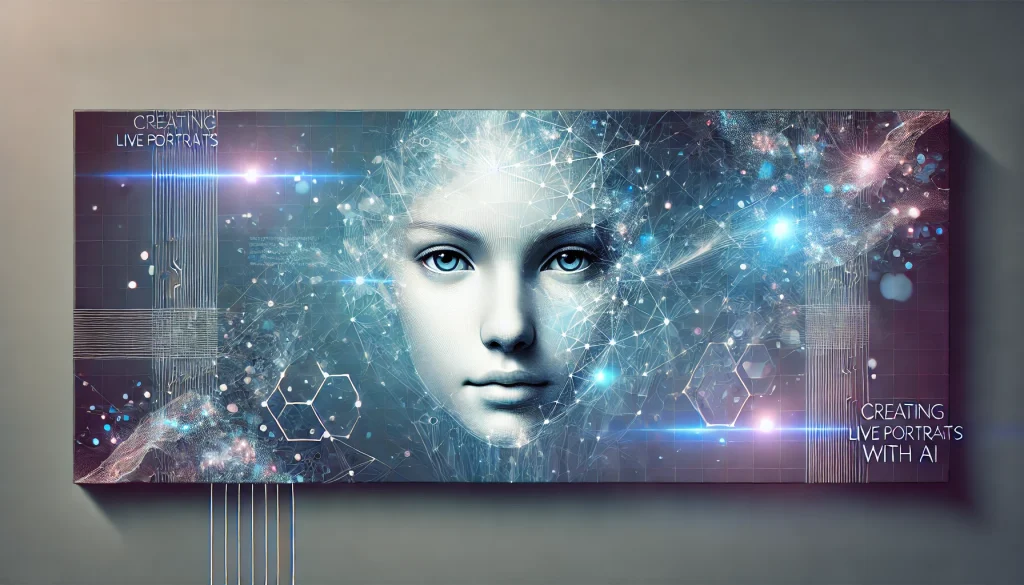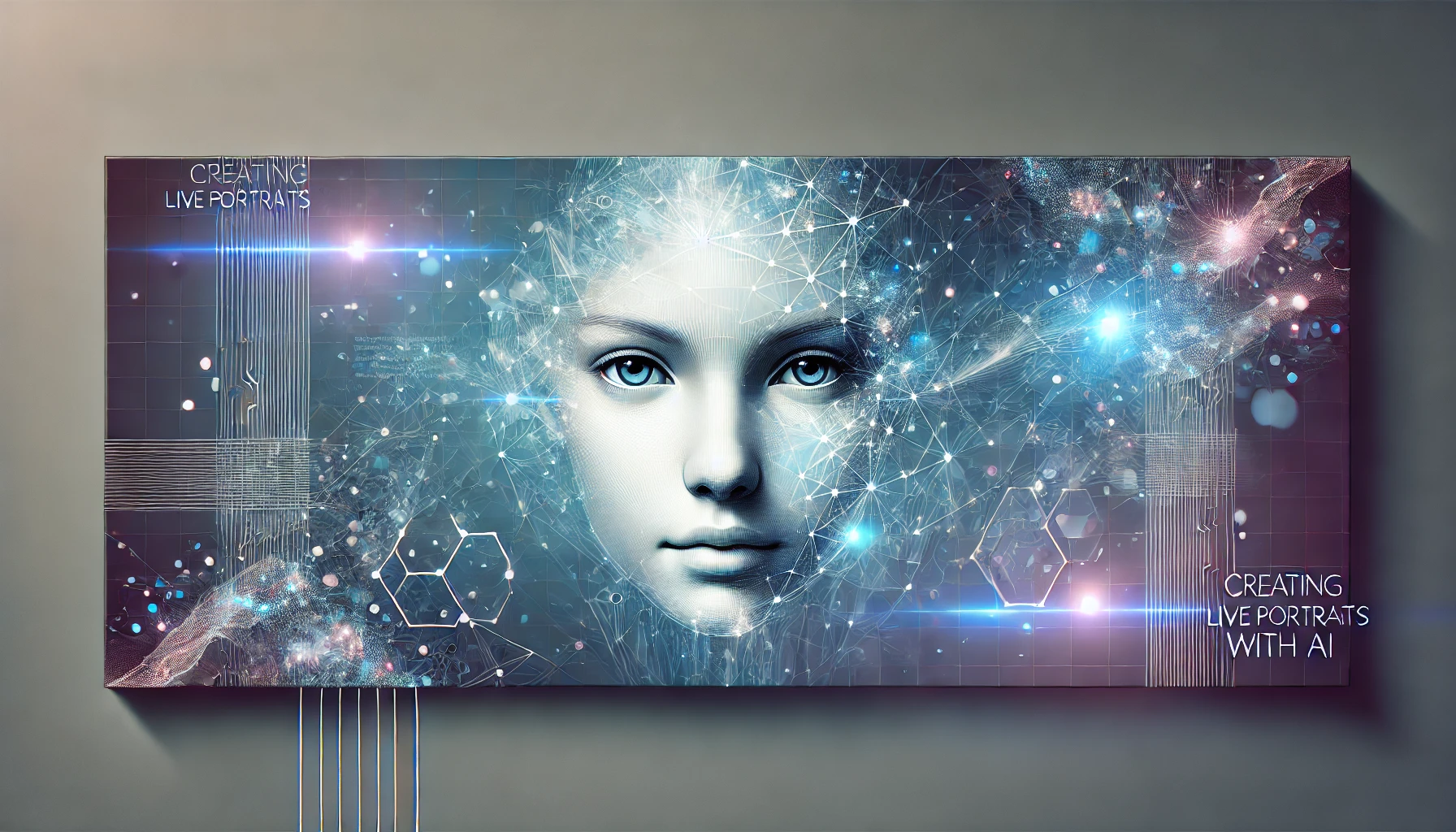
Imagine looking at an old family portrait, and suddenly, the people in the photo come to life—they blink, smile, and even move their heads slightly. It sounds like something straight out of a sci-fi movie, but thanks to advancements in AI, this is no longer just a fantasy. AI-powered live portraits are becoming a reality, transforming static images into dynamic, lifelike animations.
In this article, we’ll dive into how AI is revolutionizing portrait creation, how live portraits work, and how you can create your own. Let’s explore this fascinating blend of technology and art that’s changing the way we think about photography.
What Are Live Portraits?
A live portrait is a static photo or image that is brought to life using AI. Through machine learning, the AI can analyze a still image and predict how a person in the photo would move in real life. The technology captures subtle expressions like blinking, head tilts, and even smiles to make the subject appear as if they were alive in the moment.
These AI-generated live portraits give a whole new dimension to memories. Instead of just capturing a single moment, you can now bring that moment to life. It’s like adding a sprinkle of magic to everyday photos, making them more interactive and captivating.
How Does AI Create Live Portraits?
Creating live portraits involves some seriously smart AI tech. It’s not just about animating random parts of the face; the AI needs to understand the human face, how muscles work, and how expressions form naturally. Here’s a simple breakdown of how the technology works:
- Image Input: You start with a static portrait or photograph. It could be a recent picture or even an old black-and-white image from years ago.
- Facial Mapping: The AI uses machine learning algorithms to map out key features of the face, such as the eyes, nose, mouth, and jawline. It studies how these parts move and how muscles behind the face create expressions.
- Motion Prediction: Once the face is mapped, the AI predicts how the person might move if they were alive in that moment. This includes natural movements like blinking, tilting the head, or smiling.
- Animation Generation: Based on these predictions, the AI creates a short video loop that animates the face. The result is a live portrait where the person in the image moves in a lifelike way.
Popular AI Tools for Creating Live Portraits
There are several AI-powered tools available that make creating live portraits super easy, even if you’re not a tech expert. Let’s take a look at some of the most popular ones.
1. MyHeritage Deep Nostalgia
One of the most well-known tools for bringing old photos to life is MyHeritage’s Deep Nostalgia. It uses AI to animate faces in historical family photos. The app became famous for its ability to make ancestors blink, smile, and even turn their heads, turning a lifeless portrait into a living moment.
How it works:
- Upload a photo, and the AI analyzes the face.
- You can choose from different animations, such as smiling or looking around.
- The app then generates a video loop where the face moves naturally.
Why it’s popular:
- Easy to use, even for beginners.
- Brings a new layer of emotion to family history by making ancestors appear more lifelike.
2. MugLife
If you want more control over how a live portrait moves, MugLife is a fun and powerful app. It’s designed to let users create 3D animations from still photos. You can control expressions, add funny faces, or even make the portrait sing or talk.
How it works:
- Upload a photo, and the AI scans the face to create a 3D model.
- You can manipulate the facial movements and expressions yourself, or let the AI generate them automatically.
- Export the live portrait as a GIF or video and share it on social media.
Why it’s popular:
- Great for creative users who want to add more personality and humor to their live portraits.
- Offers detailed control over expressions and movements.
3. Wombo
Ever wanted to see a portrait lip-sync to a song? Wombo is the app for that. It uses AI to turn any portrait into a singing, animated character. While it’s not designed for creating subtle, realistic live portraits, Wombo is pure fun and lets you make any image lip-sync to a wide variety of songs.
How it works:
- Upload a photo, and the AI analyzes the face’s mouth and expressions.
- Select a song from the app’s library.
- The AI then animates the face to make it look like the person in the image is singing the song.
Why it’s popular:
- Pure entertainment value—watching someone’s portrait sing a goofy song is always a hit.
- Simple to use, with quick results that are perfect for sharing on social media.
The Magic Behind the AI: Machine Learning and Facial Recognition
The secret sauce behind live portraits lies in machine learning and facial recognition. AI algorithms are trained on thousands of images and videos of people’s faces in motion. By studying these movements, the AI learns how different parts of the face interact when we express emotions or talk.
Over time, this learning allows the AI to predict realistic movements even when only given a still image. The algorithms use this knowledge to animate the eyes, mouth, and other facial features in a way that looks natural. This is why live portraits can seem so lifelike, even though they’re generated from just a photo.
Use Cases for Live Portraits
While live portraits are fun and entertaining, they also have some meaningful uses beyond entertainment. Here are a few examples of how live portraits are being applied:
1. Family History and Genealogy
One of the most touching uses for live portraits is in the world of family history. Tools like Deep Nostalgia have allowed people to see their long-gone ancestors in a new light. Instead of a distant, frozen moment in time, live portraits let us imagine what these people were like in real life—breathing, smiling, and making natural movements.
2. Social Media Content
As with most new tech, social media has embraced live portraits as a fun and engaging form of content. Whether it’s a throwback photo brought to life or a fun animation, people love sharing these AI-generated clips with their followers. Apps like Wombo and MugLife make it easy to create viral-worthy content in minutes.
3. Virtual Characters and Storytelling
In the creative industry, live portraits are being used to create virtual characters for storytelling, games, and even education. Imagine a history lesson where a historical figure like Abraham Lincoln is animated and “speaks” directly to students. This application of live portraits can make learning more interactive and immersive.
Ethical Considerations and the Future of AI Live Portraits
As with all AI technology, there are some ethical considerations when it comes to live portraits. For example, animating the faces of deceased individuals might raise concerns about consent, especially if the person in the photo didn’t agree to be portrayed in such a way.
Moreover, as AI continues to advance, there are questions about how this technology might be used for more serious applications, such as deepfakes. While live portraits are mostly harmless fun, there’s potential for misuse when AI-generated content is indistinguishable from real-life videos.
Looking ahead, AI-powered live portraits are only going to become more sophisticated. As machine learning improves, we can expect more realistic animations, better motion capture, and even more interaction with AI-driven characters. The future of portraits isn’t just static anymore—it’s alive, dynamic, and ready to change the way we look at photography.
How to Create Your Own Live Portrait
Want to try making your own live portrait? It’s easier than ever, thanks to apps and tools that do most of the work for you. Here’s a step-by-step guide to creating your first live portrait:
- Choose an AI App: Pick an app like MyHeritage Deep Nostalgia, MugLife, or Wombo based on what you want to do with your live portrait.
- Upload Your Photo: Select a clear portrait where the face is easily recognizable. The better the quality, the better the results.
- Customize (Optional): Some apps allow you to customize movements or expressions. Play around with the settings if you want more control.
- Generate the Animation: Let the AI work its magic and create the animation. This usually takes just a few seconds.
- Share It: Once your live portrait is ready, you can save it as a video or GIF and share it on social media, with family, or just enjoy it yourself.

